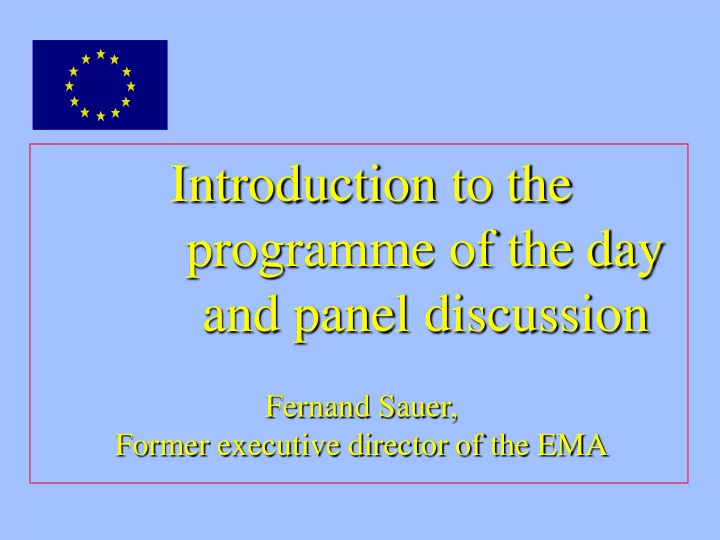

Introduction to the programme of the day and panel discussion Fernand Sauer, Former executive director of the EMA
Objective of the public workshop Assist EMA in the annual review of its policy on the handling of conflicts of interests (CoIs) of scientific committee members and experts (April 2012). Main question for the meeting: • How to achieve the right balance between ensuring the impartiality and independence of experts involved in the Agency’s work, versus the need to secure the best- possible scientific expertise to continually deliver high- quality scientific assessments • In the context of the EMA regulatory framework
Experts in the EMA regulatory framework: • Most experts are nominated by the Member States. • Were there is a need for additional expertise, the EMA can nominate the identified expertise. • Scientific Committee members are generally nominated by the Member States; some members are nominated by the European Commission to represent patients and healthcare professionals. • All Scientific Committee members and experts must be included in the EMA experts database prior to involvement in any EMA activity.
EMA assessment of Conflicts of Interests • Direct and indirect interests are considered, as well as their nature, timeframe and the type of the EMA activity. • Focus on direct interests in pharmaceutical industry, resulting in the highest risk level and the most restricted involvement in EMA activities. • Requirements for membership of EMA decision-making bodies are stricter than for EMA advisory bodies • Requirements for chairs and members in a lead role (e.g. rapporteurs) are stricter compared to other members of the EMA scientific fora.
EMA handling of Conflicts of Interests • CVs and declarations of interests of all experts are published online, as well as their assigned risk level. • Minutes of meetings for 3 Scientific Committees (COMP, PDCO, PRAC), including the restricted involvement of some members, are published on the EMA website. • It is envisaged for the minutes of the meetings of the remaining Scientific Committees (CAT, CHMP, CVMP, HMPC) to be published before the end of 2013.
Programme of the day / Morning Nine short presentations by panel members : • Academia (Human & Vet) • Chairs of 3 EMA bodies : Paediatric Cttee, CVMP, Neurology Scientific Advisory Group • Stakeholders : Patients & Industry, • NGO & Drug Bulletins Followed by panel discussion on concrete solutions suggested in the short presentations
Programme of the day / Afternoon Questions and suggestions from all participants* during 3 successive sessions of ½ hour : • How could the Agency make it more attractive for experts and widen the pool of available expertise? • Are the EMA safeguards adequate, not strong enough, or too restrictive? • What additional elements would be useful when revising the Agency’s CoI policy and its practical operation? Concluding remarks by EMA representatives * Preferably in a short note to the chair, with your name and question, before lunch break
Panel presentations by: • Wolf-Dieter Ludwig Chair, Drug Commission of the German Medical Association • Rory Breathnach University College Dublin, Small Animal Medicine • Daniel Brasseur Chair, Paediatric Committee • Anja Holm Chair, Committee for VeterinaryMedicinal Products • Serge Bakchine Chair, Neurology SAG • Nikos Dedes President, Association of People Living with HIV in Greece; former Chair of the European AIDS Treatment Group • Richard Bergström Director-General, European Federation of Pharmaceutical Industries and Associations • Martin Pigeon Researcher, Corporate Europe Observatory • Pierre Chirac Editor, Prescrire; President, Association Mieux Prescrire
Recommend
More recommend